Amorc has traditional clout.
This is the secret behind its initiation rituals.
Today I’m going to blow the lid off a well-kept secret from within Amorc. I’m going to show you where their initiation rituals really come from and for good reason. Amorc probably keeps this little gem secret from its members because they find it a bit embarrassing. Their initiation rituals are not ancient pre-se, but they do have a lovely story to tell.
As a traditionalist, I believe Amorc should be proud of these roots.
This blog post is also in appreciation of those members of Amorc who have come forwards and joined our Facebook community. It is in fact an addendum to the previous review of Amorc of 2014 which has now been updated and included in my 2019 final AMORC review.
In my last blog post I carried out a review of Amorc, this being the first of my Reviews of the Rosicrucian Orders. This initial review was done to measure their Traditional Score, measuring how well they stand up against the ideals set out by our Rosicrucian forefathers. As readers know this series is set to review all the major Rosicrucian Orders for their traditional and spiritual merits.
It seems the Amorc review upset a few people. That was not the purpose 🙂
Several Amorc fans expressed some disappointment, even suggesting that my blog post was a direct attack on Amorc. It was not. As mentioned there are two reviews for each Order, the first being the Traditional Score, the second being the Spiritual Score.
I will repeat here: Amorc does very well in terms of its Spiritual Score.
The reason Amorc did so badly in that review was because I compared it against the Pillars of the Rosicrucian Tradition, a standard I set out based upon the founding Rosicrucian documents.
To recap that review:
Amorc has a scant form of Pansophy, very little Trinosophy (alchemy, cabala, magic), practically to zero Christianity. It has been determined that all these aspects were an integral part of our current as set out in the early Rosicrucian manifestos. These three aspects, Pansophy, Trinosophia, Hermetic-Christianity are unavoidable in terms of Rosicrucian tradition.
That is why, for all means and purpose, Amorc stumbled with a score of 29 out of 100.
BUT there is more to this story.
The plot here thickens. I did find more hidden roots.
The R.C Pillars are an important measuring stick. They draw upon the early foundations known in German as the ‘early Rozenkreuzer phase,’ being the early 1600’s. But of course the Rosicrucian tradition did not stop there. It kept evolving.
In fact several German & French Orders arose claiming themselves to be the ‘true hidden brotherhood’ which was revealing itself openly for the first time. Several of these Orders claimed to have the Philosophers Stone, or to know the true secrets of initiation and Freemasonry, that they themselves created Freemasonry and that they alone could explain the highest order of mysteries possessed since the time of Adam’s fall. The activity of these Orders is known as the ‘second Rosenkreuzer phase.’
Considering that Amorc did badly in its Traditional Score does not write off Amorc’s traditional value completely. In so far as it has been reviewed, it really has only been reviewed against the early Rosenkreuzer phase. But, it has not been reviewed against the second Rosenkreuzer phase.
Let me state here, that to review any Order’s traditional value against the standards of the Pillars of the Rosicrucian Tradition is to specifically consider how that Order stacks up against the propositions put forwards by our founders at its very earliest stages. The six manifesto documents that comprise the standard were published in a very short period, from just 1616 until 1618. These six manifestos absolutely determine the intentions of our true founders.
My reviews determine how true an Order’s cause in relation to those original intentions.
At the same time; to deny that the Rosicrucian tradition did not continue and evolve on its own would be misleading. The second Rosenkreuzer period shows this and those Orders expanded upon the original scope. So in comparison my Pillars of the RC Tradition view Orders from a very PURIST point of view, after all I am defining my own Order here.
Now, some people have recently called me a ‘Rosicrucian thought leader’ and maybe eventually the title will sit comfortably. Either way, without my friends poking names and making fun, I have committed to a path of helping others enrich their Rosicrucian journey. A large part of that is emphasizing tradition & creating awareness about our heritage.
The Rosicrucian Reviews encapsulate my initial quest to recover our lost roots.
I don’t expect all Orders to do well against the Pillars. Amorc did badly and is not the worst for wear compared to other upcoming reviews. What did happen in my Amorc review however was that I formulated a point, which was an original conclusion of my own.
I highlighted a connection between Amorc and a certain Egyptian Order.
That thought kept bugging me. I dug a little deeper. Leaving no stone unturned this addendum was written because as it turns out the Rosicrucian-ritual connection is pretty bloody good.
But make no mistake. Before I disclose this revelation, I stand firm with the previous review.
Amorc’s monographs do not teach Rosicrucian mysteries. Their administration knows little about Rosicrucian mysteries today. Very little of their magazine or museum contain Rosicrucian teachings (Trinosophia, Hermetica, Pansophia, Theosophia) But the realm where we can uncover their traditional heritage is in the initiations they use, including its furniture & symbols.
What most people do not know is that the ritual tradition from Amorc came from another Order.
Introducing the Egyptian Rite of Memphis Misraim
Your Rosicrucian Bang for Your Buck
for Uncovering the Rosicrucian Tradition Behind AMORC.
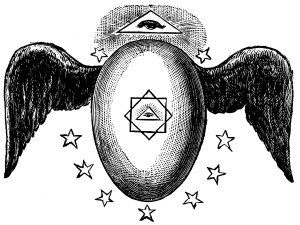 Strangely a lot of people have never heard of the Memphis Misraim, which is itself a very Rosicrucian body. Most Amorc subscribers have mentioned a few times that they thought Amorc has little to do with Freemasonry. By and large they are right. Amorc and Freemasonry are two separate entities with very different aims. And yet this assumption is dead wrong when it comes to the Rite of Memphis Misraim, largely known as Egyptian Freemasonry, a tradition I had the good fortune of being initiated into in Sweden thanks to Mikael Gejel & Fin N. 🙂
Strangely a lot of people have never heard of the Memphis Misraim, which is itself a very Rosicrucian body. Most Amorc subscribers have mentioned a few times that they thought Amorc has little to do with Freemasonry. By and large they are right. Amorc and Freemasonry are two separate entities with very different aims. And yet this assumption is dead wrong when it comes to the Rite of Memphis Misraim, largely known as Egyptian Freemasonry, a tradition I had the good fortune of being initiated into in Sweden thanks to Mikael Gejel & Fin N. 🙂
How and why Amorc is related to the M.M is fascinating. This post will prove the point.
In my Amorc review I stated that ‘Amorc is essentially the Egyptian Rite of Memphis Misraim without the masonic-builder legend.’ Not only was this a hunch that turned out to be bang on, but it also turned out that Amorc founder Harvey Spencer Lewis purposefully did this, fully knowing that he was changing the rituals & gutting out the masonic legend.
For readers who don’t follow, Egyptian Freemasonry is NOT the same as regular Freemasonry. Regular freemasonry is largely English or Scottish, and draws upon the builder legend surrounding King Solomon’s temple. Traditional history inside regular Freemasonry claims that one of King Solomon’s master builders was named Hiram Abif, and it was he who learned the secret wisdom of Solomon which was passed on through his builder’s guild, as the secret mysteries of temple crafting. Their craft became a philosophical one, with the aim of building a temple of an enlightened humanity.
Egyptian Masonry on the other hand is generally disliked by regular Freemasons. Instead of having just 33 degrees, the Rite of Memphis Misraim has 99 mystery initiations in total.
The main difference here is that they claimed an Egyptian origin. Instead of dating back to the builders of Solomon’s temple, they saw themselves as an extension of the architects of Egypt, who had crafted the pyramids and witnessed the ancient mysteries there. It was their brotherhood, they claimed, who had continued the ancient mystery religions of Egypt, Persia, the Hebrews and Greece, all of which they had witnessed and transmitted into their Egyptian Freemasonry.
Amorc in its traditional history also claims to descend from the Egyptians, namely from Imhotep, or as some say Akhenaten. This is where you’ll start seeing the cross-over from Egyptian Masonry.
In fact the Rite of Memphis Misraim is a combination of two earlier rites, the first was the Rite of Misraim, and the second the Rite of Memphis. Both had different founding legends.
The Rite of Misraim started in 1803 as an extension of Cagliostro’s Egyptian Masonry. According to its legend Misraim was the grandson of Noah, who after surviving the flood left and founded Egypt. He is known as Menes, the first of the pharaohs and introduced Cabala and architecture to the Egyptians. As with Rosenkreuz he had a seven sided tomb, surrounded by seven planetary gems and above his sarcophagus burned an ever-burning fire. This Rite was Hermetic, Cabalistic and consisted of 80 degrees.
The Rite of Memphis was established in 1838. It too had high degrees, apparently 88 in total. Their founding legend was Rosicrucian, claiming that an Egyptian sage named Ormus, who was a high priest in the temple of Serapis, was converted to Christianity by Mark in 96AD. Ormus is said to have rectified the Isis and Osiris mysteries with this new Christ revelation.
The difference the Rite of Memphis had from that of Misraim was that it had more emphasis upon Templarism, chivalry and gnostic Christianity. According to my historian friend Milko the Rite of Memphis was an attempt to Christianize the earlier Rite of Misraim. Both rites taught illuminism, the doctrine of reintegration and had philosophic, cabalistic and magical phases of work.
It was in 1881 that the Rites of Memphis and of Misraim were brought together into one form of Egyptian Masonry.
The new form of Egyptian Masonry, the Rite of Memphis-Misraim became a blend of both, containing the best elements of each order. Personally I prefer the Rite of Misraim in that it contains more occult ritual. I might also add that many prominent figures were members, including Blavatsky, Steiner, Westcott, Crowley, Papus, Reuss, Yarker to name a few.
And, of course, Harvey Spencer Lewis was a member.
This is where it gets interesting.
F.U.D.O.S.I charges Harvey Spencer Lewis.
The year was 1934, August the 8th to be exact. Spencer Lewis on this day was initiated into the 86th, 87th, 88th, 89th and 90th degrees. On this particular day a reorganization of the M.M was decided amongst Rosicrucian leaders, who mutually recognized each other and who had been exchanging their initiations to help ratify their Rosicrucian authority. I don’t need to repeat the F.U.D.O.S.I story here, other than mentioning the fact that most of the French and Belgian Rosicrucian bodies were present.
At this conference which lasted several days a conclusion was arrived to. The F.U.D.O.S.I agreed that the origin of the ‘Antient and Primitive Rite of Memphis-Mizraim’ had to be a Rosicrucian source.
Thus at the meeting the Belgian brothers used this to state that the French branch was a body representing the Rite of Memphis instead of the joined Memphis-Misraim. They declared that they had found old documentation from the year of 1818 of the original Rite of Misraim and they considered that it was the right moment for a renewal of the complete Rite.
Historian and personal friend Milko Boogard writes:
 “According to F.U.D.O.S.I this would be a ‘Rosicrucian Renewal,’ carried out by the First Imperator of the Rosicrucian Order, Harvey Spencer Lewis.”
“According to F.U.D.O.S.I this would be a ‘Rosicrucian Renewal,’ carried out by the First Imperator of the Rosicrucian Order, Harvey Spencer Lewis.”
It is here that we see evidence for a transition of the rituals themselves from the masonic styled Memphis-Misraim rites which now would be transformed into purely Rosicrucian ones as thereafter used by Amorc. Now that Spencer Lewis had the authority and agreement from his Rosicrucian peers he would take it upon himself to take the essentials of the rituals and transform them into a new Rosicrucian form.
The Rosicrucian Renewal of the M.M also meant that the masonic elements had to be removed. No more legend about Hiram Abif the master builder. No more secrets about King Solomon’s temple. No more square and compass. But the Egyptian elements that made Memphis Misraim so special would remain. That is why Rosicrucian Park looks that way.
There are two major proofs that end the argument of the M.M origin of Amorc.
The Shekinah Altar has been used in Amorc’s ceremonies since the beginning. It is always shown as a three sided altar. It appears in the center of the San Jose headquarters for major rituals. You can see it depicted here in an Amorc convocation held last year. I might also add that Papus included the use of this altar in Martinist rituals, but Papus freely admitted that he drew it from the Rite of Memphis Misraim. Today Amorc does not possess the oral tradition that goes with this triple altar although this remains with some Misraim bodies and when I received this I felt it important enough to include into our own Order. As an object it depicts a mystic marriage which is of a mystical-erotic nature and relates to the Isis-Osiris mystery.
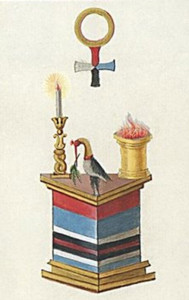 I will further add that the Rite of Misraim actually obtained it from Cagliostro and his earlier Egyptian Rite. You can see the on the right the original form of the triple altar as depicted in his Trinosophia, often attributed to St Germaine. The lineage from Cagliostro to the M.M is quite an interesting one worth further study. 😉
I will further add that the Rite of Misraim actually obtained it from Cagliostro and his earlier Egyptian Rite. You can see the on the right the original form of the triple altar as depicted in his Trinosophia, often attributed to St Germaine. The lineage from Cagliostro to the M.M is quite an interesting one worth further study. 😉
Then there is the second in your face M.M symbol used by Amorc.
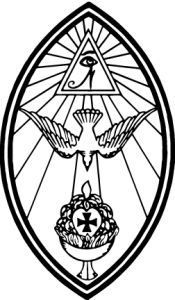 The Seal of Amorc was a matter of much dispute. In fact this seal is the same seal as derived from the Rite of Memphis Misraim in Germany then headed by Theodore Reuss. Harvey Spencer Lewis even came under attack at one point because Crowley had become the head of the rite and claimed that he therefore should exercise authority over Amorc as well. Needless to say Amorc does not use this seal today due to the M.M/OTO connection. If you look at F.U.D.O.S.I certificates Amorc’s (then used) seal and Lewis’ own signature also appears alongside the winged egg symbol of the Egyptian Rite.
The Seal of Amorc was a matter of much dispute. In fact this seal is the same seal as derived from the Rite of Memphis Misraim in Germany then headed by Theodore Reuss. Harvey Spencer Lewis even came under attack at one point because Crowley had become the head of the rite and claimed that he therefore should exercise authority over Amorc as well. Needless to say Amorc does not use this seal today due to the M.M/OTO connection. If you look at F.U.D.O.S.I certificates Amorc’s (then used) seal and Lewis’ own signature also appears alongside the winged egg symbol of the Egyptian Rite.
The traditional history of the Rite of Memphis-Misraim stated that the Rite began with Misraim, the first pharaoh of Egypt. This is why after speaking with Lewis Crowley also writes of Lewis saying: ‘He said the Order was founded by one of the early Egyptian kings and professed to have documentary evidence of an unbroken hierarchy of initiates since then.’
Clearly at this time Lewis was borrowing from the traditional history of Memphis-Misraim and not that of the Rosicrucian manifestos which speaks only of Christian Rosenkreuz.
Later we find that Lewis would replace the good king ‘Misraim’ with Akhenaten in his founding mythos. This was done in order to further separate Amorc from the masonic Misraim legend. My estimation is that Lewis actually had quite a bit of time to digest and plan this out carefully seeing that although the charge to renew the M.M in a Rosicrucian fashion was finally made in 1934 in fact Lewis had been working with the Egyptian Rite since before the 1920’s.
To add to the seal and triple altar (as if it is not enough) we must consider how the Memphis-Misraim was stylized in terms of not only its rituals but also its regalia and certificates. Lewis saw that Amorc would benefit from all of these, taking on the rites’ use of Egyptian winged sun emblems, Egyptian pillars and on occasion hieroglyphic seals that would adorn Amorc documents. Although the M.M triple altar is really the pink elephant in Amorc’s room it is needless to say that the Egyptian iconography speaks for itself. Before Amorc appeared no Rosicrucian body had made use of such extensive Egyptian imagery, other than the Rite of Memphis-Misraim, which has clearly left its footprints upon Amorc.
I believe you should follow such footprints, as they trace the way back from whence your tradition came. If you are a member of Amorc and this post is as annoying as my last, I say to you: don’t worry. 🙂 This is something that enriches your heritage. The Rite of M.M is beautiful, compelling & rich. With its mysterious 99 initiatory degrees the rite had inherited the height of the illuminist teachings at the time. The charge to Lewis to renew the M.M rituals is not a nail in the coffin proving a story, it is a real connection you can be proud of.
What’s more, this rite itself had an earlier Rosicrucian origin. But that is another story..
 For now, you’ll want to read my full AMORC Review. Don’t miss!
For now, you’ll want to read my full AMORC Review. Don’t miss!
Thanks for reading the blog.
Comments enabled below.
Samuel Robinson
Founder of Pansophers


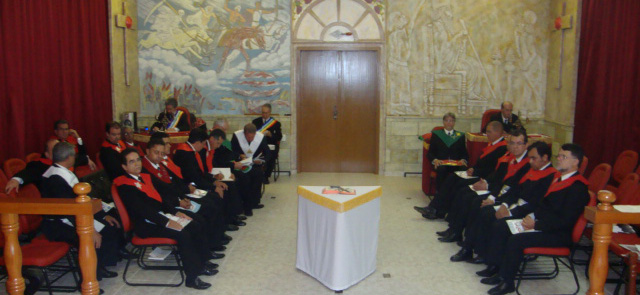

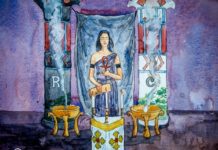
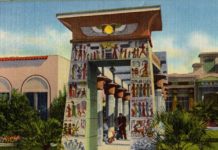






Sam shows once again his unbiased research and uncovering the truth and value of each Order.
Excellent work !
I’ve been a member of AMORC for a decade, and I came to the same conclusion years ago. It gave me a strong desire to pursue the Rite of Memphis-Misraim; unfortunately, there is no lodge that would not require very extensive traveling on my part. A lot of people criticize AMORC despite the fact that it emerged, albeit quite late to the game, from the same 19th-century occult revival as the GD and the myriad of other orders out there. As a longtime member and an officer (former archivist and current master), I can attest to the fact that the egregore is powerful and beautiful; however, it is not for everybody. Unfortunately, many people, members and non-members alike, believe the mythical backstory of AMORC to be literal rather than allegorical. Although, he was a real person, the tale of Akhenaten is no more real than that of Hiram Abiff in Freemasonry. Metaphor and parable go hand-in-hand with the occult. I believe that the influence of the Memphis-Misraim, as well as various Martinist and Golden Dawn influences, add to its depth and richness.
Amorc I have hard of it.
I like to b a member
The triple altar originates in the Henry Andrew Francken Manuscript of 1783. You just have to know how to assemble both it and the tomb. I enjoyed your interpretation though.